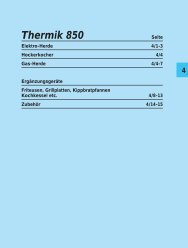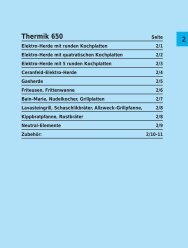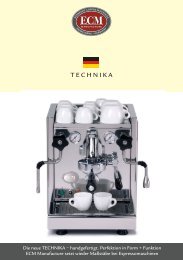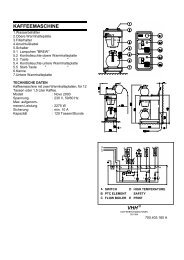Office Leva EX 237 2 Kessel
Office Leva EX 237 2 Kessel
Office Leva EX 237 2 Kessel
Create successful ePaper yourself
Turn your PDF publications into a flip-book with our unique Google optimized e-Paper software.
Americano. This is still a very nice drink but not what you intended here. This is a very<br />
common mistake with new lever machine users. This writer actually developed a liking<br />
for Americanos by making this mistake three times in a row over two days!<br />
At this point, feel free to enjoy your double espresso and come back later to do the few<br />
minor points of cleanup which will be discussed next. However, if you are making a<br />
cappuccino, let’s move on…<br />
Frothing: Much has been written about the subject of frothing when actually it is the<br />
easiest part of the brewing ritual. The main factors to successful frothing are: 1) Use the<br />
correct sized pitcher and fill it no more than a third full as the milk will triple in volume.<br />
2) Chill or freeze the pitcher and use very cold milk. 3) Use a frothing thermometer until<br />
you learn to “feel the heat” in the pitcher.<br />
There are two techniques that are commonly used to froth, but first point the steam wand<br />
into the trip tray and open the valve slightly to release any watery steam. You want pure<br />
steam vapor.<br />
The first technique involves inserting the steam tip just off-center and barely under the<br />
surface of the milk to circulate it and create foam. Do this until the thermometer reaches<br />
100 degrees. Then bury the wand to about 1/8 th of an inch from the bottom and tilt the<br />
pitcher slightly to create a vortex in the milk. Continue until the milk reaches a temp of<br />
155 to 160 degrees, but no higher or you will scorch the milk. The pitcher should now<br />
contain froth up to the brim.<br />
The second technique is just the opposite in that you begin with the wand near the bottom<br />
of the pitcher and as the thermometer rises to 100 degrees, you very slowly bring the<br />
wand up to the surface, always maintaining the vortex. This is called “stretching”.<br />
After you have finished frothing and set the pitcher down, immediately take a wet cloth<br />
or small scouring pad and clean the drying milk from the wand. Point the wand into the<br />
drip tray again and open the valve briefly to clear the tip of dried milk.<br />
One final note—do you pour or may you spoon the foam into the cup? The vast majority<br />
of home baristas admit to using a spoon most of the time. The professional baristas insist<br />
pouring is the only acceptable method. If your pitcher contains near-perfect microfoam,<br />
then by all means, learn to pour and thus you will have taken the first step to learning<br />
latte art.<br />
The Quick and Final Cleanup: You left the lever in the full down position after pulling<br />
your shot, so remove your portafilter handle and give it a tap on the knock box. The dry<br />
puck should fall out leaving a clean basket, requiring only a quick wipe with a bar rag or<br />
paper towel. Next move the lever up to brew for a couple of seconds to rinse any residue<br />
off the shower screen with hot water and then give it a wipe.<br />
21






